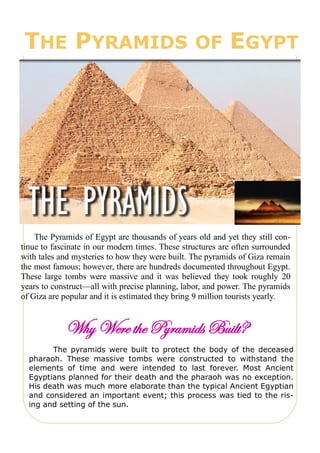
Egyptian Pyramids
- 1. THE PYRAMIDS OF EGYPT The Pyramids of Egypt are thousands of years old and yet they still con- tinue to fascinate in our modern times. These structures are often surrounded with tales and mysteries to how they were built. The pyramids of Giza remain the most famous; however, there are hundreds documented throughout Egypt. These large tombs were massive and it was believed they took roughly 20 years to construct—all with precise planning, labor, and power. The pyramids of Giza are popular and it is estimated they bring 9 million tourists yearly. Why Were the Pyramids Built? The pyramids were built to protect the body of the deceased pharaoh. These massive tombs were constructed to withstand the elements of time and were intended to last forever. Most Ancient Egyptians planned for their death and the pharaoh was no exception. His death was much more elaborate than the typical Ancient Egyptian and considered an important event; this process was tied to the ris- ing and setting of the sun.
- 2. The Pyramids of Egypt The Great Pyramid(Khufu’s pyramid ) When the Great Pyramid of Egypt was built it was 146 meters (480 feet) tall. Time has worn the pyra- mid down to 138 meters (455.4 feet) and it still con- tinues to erode. The pyramid was once covered with limestone that was polished and believed to be left white. The sides of the pyramid are carefully posi- tioned to point north, south, east, and west. The base of the pyramid has sides that measure 230.4 meters (755.9 feet) in length. It was designed so accurately, that the error of margin between the sides is less than 1 percent. The Great Pyramid is made up of approximately two million blocks of limestone and slopes upward 51 °. Each block used to construct the pyramid is esti- mated to weigh more than two tons. It belonged to the pharaoh Khufu and once held his body; however, today the pyramid remains empty. The Great Pyra- mid is considered the last ancient wonder of the world standing today. Khafre’s Pyramid The second pyramid belongs to the pharaoh Khafre. Unlike the pyramid of Khufu, the angle of this pyramid is 53 ° and the pyramid stands 148.5 meters (470.5 feet) tall. This pyramid is 10 meters shorter than Khufu’s, though appears to be larger due to the height of the bed- rock and stands on the northern side of the Giza Pla- teau. The top of this pyramid has a smooth limestone cap also giving it the illusion of being larger than Khufu’s pyramid too. Like Khufu’s pyramid, this tomb was also looted. Menkaure’s Pyramid The pyramid of Menkaure, or the third pyramid, is the smallest of the three pyramids. Its design is not as well detailed as the other two pyramids or is it as massive. Today it stands 66.5 meters (218 feet) and has an angle of 51 °. The base of this smaller pyramid is 108.5 meters (355.9 feet). The pyramid was not complete when Menkaure died so his son Shepseskaf took the task of finishing the project. These pyramids may appear to be alone on the Giza Plateau but are not. There are many other structures that surround these massive tombs such boat pits, queens’ pyramids, mortuary temples, valley temples, mastabas,
- 3. Steps of Building Pyramids How were the pyramids built? This question has puzzled scientist for centuries and still continues to puzzle experts today. To date, there has been no documentation or clues that have given Egyptologists answers about the construction of the pyramids. Because there are many theories and ideas as to how the pyramids were constructed, we will cover the most common theory used in constructing the pyramids. The most common theory for moving large blocks is to slide logs under the large stones to make mobility easier. The block would have been attached to large ropes with people pushing the block forward. At the same time several men would remove the last log uncovered by the stone. The end log that was removed would then be transported to the front where it would com- plete the cycle under the stone and the endless cycle would be repeated. Moving the block was one thing but placing it into position was another. This idea has also left scientist baffled. The most common theory for placement of each stone is said to have a ramp that went around the pyramid’s sides. Some have concluded that the ramp only touched one side of the pyramid. This might have been true, but the ramp might have had more material then the pyramid did and this would have made placement of each block difficult. Herodotus was a Greek historian who traveled to Egypt around 450 B.C. and wrote that the Egyptians had some sort of gear that was used in lifting these large blocks. Although this might sound extraordinary, scientists have found no proof of any such lifting devices. It’s estimated that the Great Pyramid took almost twenty years to complete due to its size and the type of stone used in creating the structure. Each stone weighed about two to five tons and came from Aswan and Tura. Not only was the stone imported but also stonemasons would have worked all year long cutting and shaping each block. All these complicated tasks made the pyramid difficult to construct but as we know today, the end results are amazing.
- 4. Structure of the Pyramids
